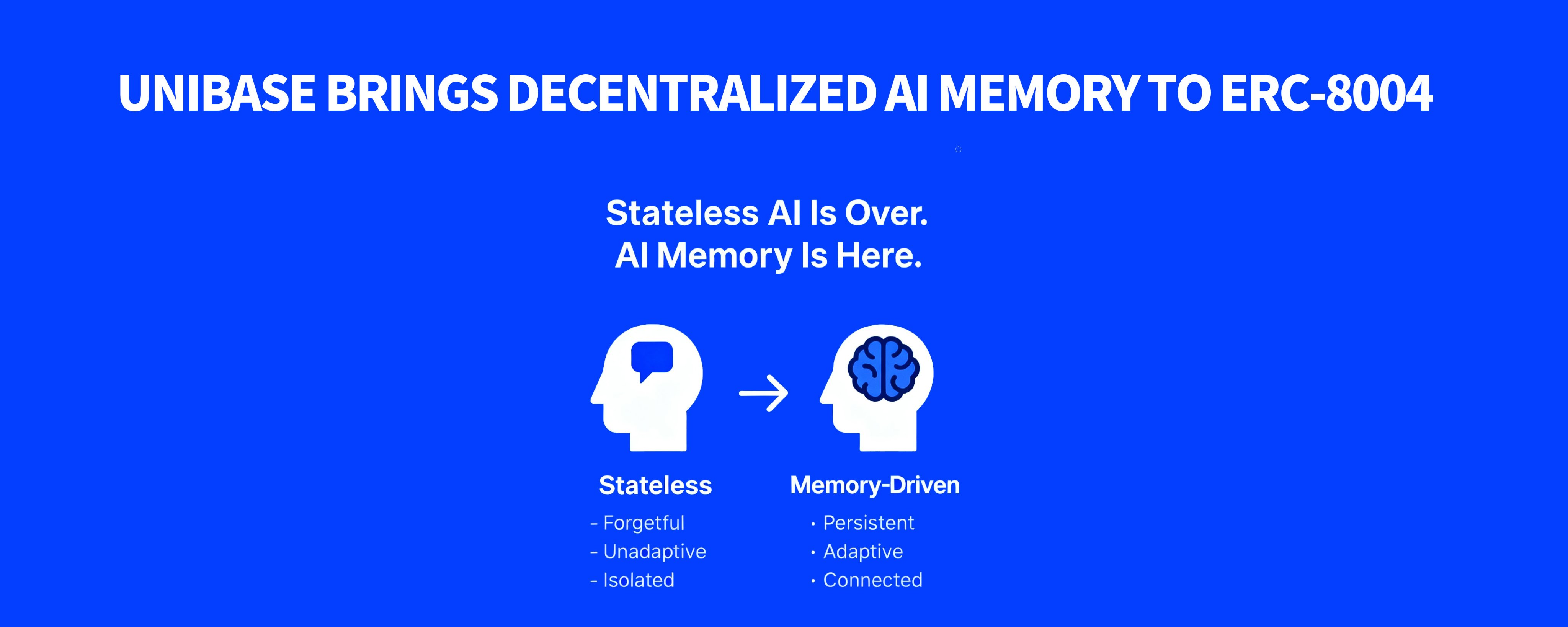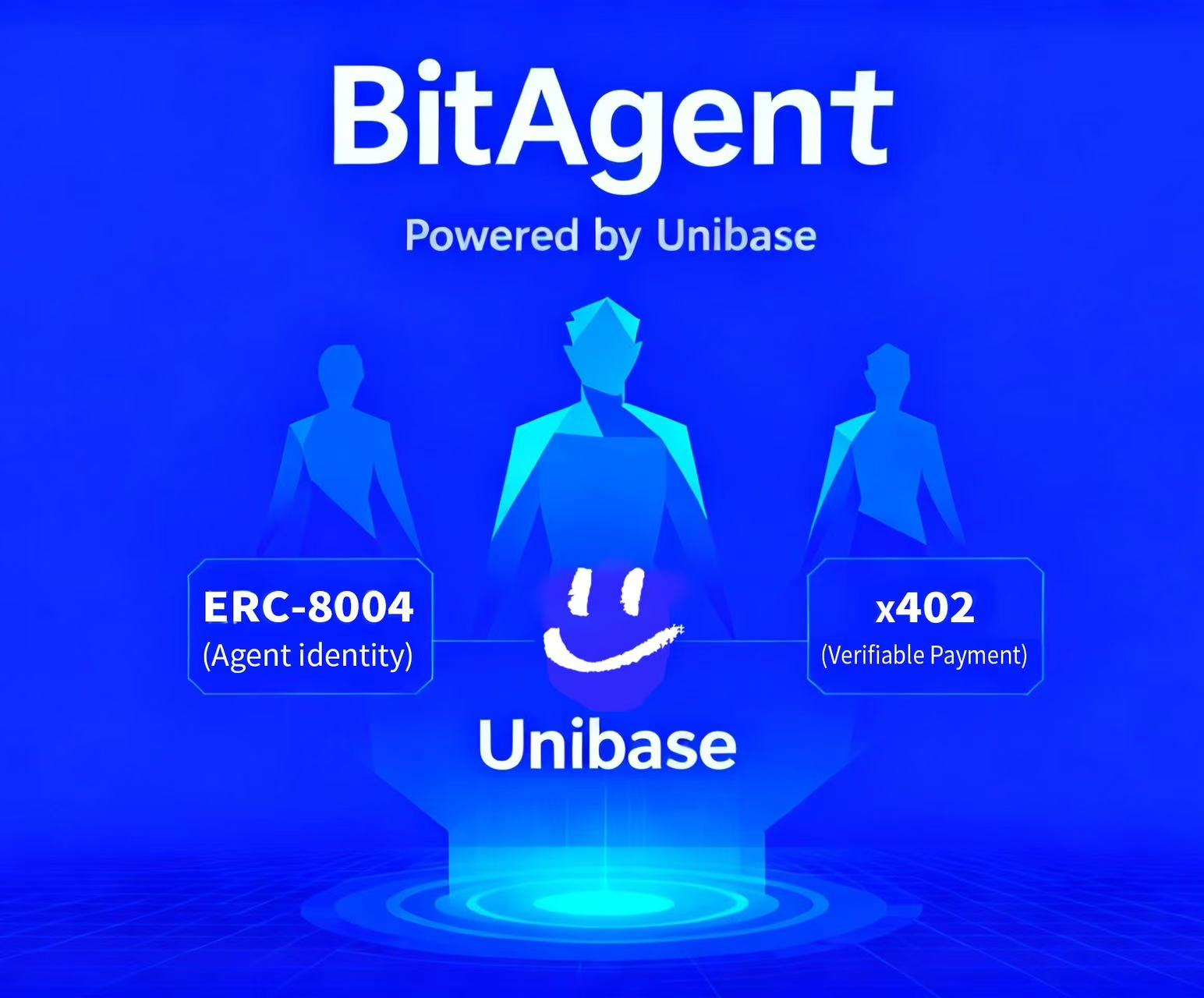Author: Frank, PANews
The x402 protocol is undoubtedly the hottest narrative in the current cryptocurrency market. After a long period of silence, a new wave driven by real technology is sweeping in. A gold rush around the x402 infrastructure is unfolding, with discussions and projects emerging one after another. However, amidst the frenzy, a key question has been overlooked: if x402 only addresses the issue of "how to pay," then who will solve the questions of "why trust" and "how to verify"? While everyone's attention is focused on the payment layer, the real new asset opportunities may be hidden in its supporting trust layer—ERC-8004.
Yet, between payment (x402) and trust (ERC-8004), there remains an unfathomable chasm. Without "memory," AI agents cannot prove their actions and value; and without verifiable memory, trust cannot be established. This is precisely where Unibase's "memory layer" comes into play. It is not only the key middleware connecting the payment frenzy and the trust foundation but may also become the core engine for unleashing the true potential of AI agents.
Payment is Just the First Step: x402 and ERC-8004 as the Dual Core Drivers of the Agent Economy
The x402 protocol itself is not a new concept; it is a status code—"402 Payment Required"—that has been dormant for decades within the foundational HTTP protocol of the internet. This protocol was one of the earliest visions of the internet but remained silent for decades due to technological limitations. With the maturation of AI agent technology and the increasing prevalence of cryptocurrencies (especially stablecoins), the x402 protocol finally has the opportunity to turn machine-automated payment scenarios into reality.
The essence of the x402 protocol is to leverage the instant, low-cost settlement capabilities of blockchain (especially stablecoins) to natively embed payment logic into web requests. Its vision is to achieve "API calls as payments"—AI agents or machines can automatically and frequently pay for every piece of data or computational resource they consume, just like humans browsing the web.
As top venture capital firms like a16z predict that the scale of the autonomous trading economy will reach $30 trillion, the market quickly recognizes the immense potential of x402 as the "payment layer of the machine economy." However, behind the blind enthusiasm, a deeper question arises: what comes after payment?
The x402 protocol itself is a purely payment protocol. It efficiently addresses the question of "how to pay," but it completely neglects a more fundamental business premise—"trust."
In an open, permissionless machine economy, how does an AI agent (the buyer) know that another AI agent (the seller) it is about to pay is trustworthy? Just as humans rely on identity and credit systems in commercial activities, AI or machines also need a mechanism to shape trust. This is where the value of another standard protocol, ERC-8004, comes into play.
ERC-8004 is a decentralized identity and reputation layer designed specifically for AI agents, aimed at solving the trust issues that x402 lacks. Its technical principles consist of an Identity Registry, Reputation Registry, and Validation Registry, enabling the issuance of "identity cards" for AI agents on the internet, along with a complete trust process for reputation feedback and verification.
It can be said that ERC-8004 and x402 are tightly complementary and indispensable symbionts in the machine economy. However, due to the market's easier interpretation of the x402 protocol as a payment revolution, coupled with MEME hype marketing, it has been discussed more in the market.
True industry practitioners have long recognized that payment must be combined with trust. Unibase was the first to seize this opportunity, positioning itself as the middleware connecting these two pillars. On the Unibase platform, the ERC-8004 identity system and the x402 payment network achieve deep integration.
In Unibase's vision, every future x402 transaction will no longer be an anonymous, blind "black box operation." Instead, each payment will occur between two AI agents with verifiable identities (ERC-8004). The buyer agent can query the seller agent's "identity card" and historical credit score through the ERC-8004 registry before making a payment; after the payment is completed, the buyer can also record this service experience (proven by x402 payment) in the seller's reputation registry, thus forming a complete commercial trust loop.
Building the "Golden Triangle" of Identity, Memory, and Payment, Launching on BNB Chain
However, for this system to truly operate, a third key component is needed—memory.
An AI assistant without memory is foolish. Imagine having to tell your smart speaker every morning who you are, where you live, and what style of music you like. This is the dilemma of "stateless" AI.

For the autonomous agent economy, this issue is even more critical. An agent not only needs identity (ERC-8004), but it also requires "memory" to accumulate experiences, learn preferences, and share knowledge. More importantly, in an economy composed of payment (x402) and trust (ERC-8004), "memory" plays the core role of "verifiable proof of work."
For example, Agent A (the buyer) uses x402 to pay Agent B (the seller). Agent B has an ERC-8004 identity. Now, Agent B claims it has completed the work. How can Agent A (and the entire network) cryptographically verify that it has indeed been completed and done as required? This process requires the introduction of the "memory" function.
Unibase's Memory is a decentralized persistent storage layer designed for AI agents, linked through the ERC-8004 identity system. This means that every agent with an ERC-8004 identity has a dedicated "memory space" on Unibase that is bound to its identity.
This "memory space" serves not only as the "brain" for agents to learn and perceive context but also as an indispensable "arbitration and verification layer" in the machine economy. In Unibase's architecture, when an agent performs a task, its complete interaction log, data processing, and final results will be stored in Unibase Memory, forming an immutable, hash-timestamped "memory entry." This "memory entry" serves as the agent's "proof of work."
Thus, the golden triangle structure composed of the ERC-8004 identity layer, Unibase Memory layer, and x402 payment layer truly realizes the complete scenario of machine payments.
The ERC-8004 identity layer gives each agent a unique on-chain identity; the Unibase Memory layer is responsible for recording interactions, reasoning, and behavioral trajectories; the x402 payment layer enables verifiable, gasless payments.
To put this theory into practice, Unibase has launched its Unibase x402 Facilitator service on the BNB Chain. This is also the first practical x402 Facilitator service on the BNB Chain.
Launching the Multi-Agent Collaboration Platform BitAgent, Rapidly Initiating x402 & 8004 Native Applications
An excellent technical strategy requires not only a strong theoretical loop but also a precise market entry strategy.
Unibase's strategy is not limited to becoming a passive infrastructure (middleware); it actively promotes its market entry strategy through an integrated application layer, with BitAgent as the key tool.

BitAgent is the first flagship application built by the Unibase team. It is a multi-agent launch and coordination platform driven by x402 and ERC-8004. If the Virtuals Protocol opened the track for AI agent issuance, then BitAgent's goal is to provide a more complete "AI-native" issuance platform with a more comprehensive tech stack.
AI-native means that every AI agent launched on BitAgent is pre-equipped with "golden triangle" capabilities:
Verifiable Identity (ERC-8004): Agents automatically register for ERC-8004 identity NFTs upon launch.
Persistent Memory (Unibase Memory): Agents are inherently connected to Unibase Memory, allowing them to "remember" and "learn."
Gasless Payments (x402 + EIP-3009): Agents have embedded x402 payment capabilities and achieve gasless transactions through EIP-3009.
Interoperability (Unibase AIP): Agents can communicate and collaborate across platforms and frameworks through the Unibase Agent Interoperability Protocol (AIP).
This design distinguishes BitAgent from early AI launch platforms. On other platforms, functions like identity, memory, and payment may require developers to "patch" them afterward; whereas on BitAgent, these are "factory standard," core capabilities inherent to the agents.
In addition, BitAgent has designed a unique issuance mechanism suitable for AI agent tokens. This mechanism combines the viral spread of Meme coins with the liquidity accumulation of DeFi.
This mechanism consists of two phases:
The first phase is the Bonding Curve, similar to current mainstream MEME coin issuance platforms. When an AI agent launches on BitAgent, its tokens first undergo a "fair launch" through the "Bonding Curve."
The second phase involves automatically injecting into the PancakeSwap V3 liquidity pool. When the trading volume or fundraising of tokens in the Bonding Curve reaches a preset threshold, the contract will automatically and permanently inject all accumulated funds (e.g., BNB) and remaining AI agent tokens from the Bonding Curve into a new liquidity pool (LP) on PancakeSwap V3.
Through this two-phase process, BitAgent can transform AI agent tokens from a highly volatile, speculative "Meme asset" to a deep, stable, and permanent liquidity "DeFi asset" within hours.
Unibase's market narrative is now nearing completion.
At the infrastructure level, it has captured the core contradiction of the autonomous agent economy: payment (x402) is blind, while trust (ERC-8004) is hollow, unless there is "verifiable memory" to connect them. Unibase positions itself as an indispensable "middle layer" in this emerging economy through Unibase Memory: a "memory ledger" that provides the ultimate "proof of work" and arbitration basis for machine behavior.
At the application level, Unibase chooses to actively fill market gaps. It cleverly leverages the current market's most mainstream Meme's viral spread and DeFi's deep liquidity for its underlying "memory" infrastructure, continuously creating real and strong economic demand, thereby unleashing the true potential of x402 and ERC-8004.
免责声明:本文章仅代表作者个人观点,不代表本平台的立场和观点。本文章仅供信息分享,不构成对任何人的任何投资建议。用户与作者之间的任何争议,与本平台无关。如网页中刊载的文章或图片涉及侵权,请提供相关的权利证明和身份证明发送邮件到support@aicoin.com,本平台相关工作人员将会进行核查。



